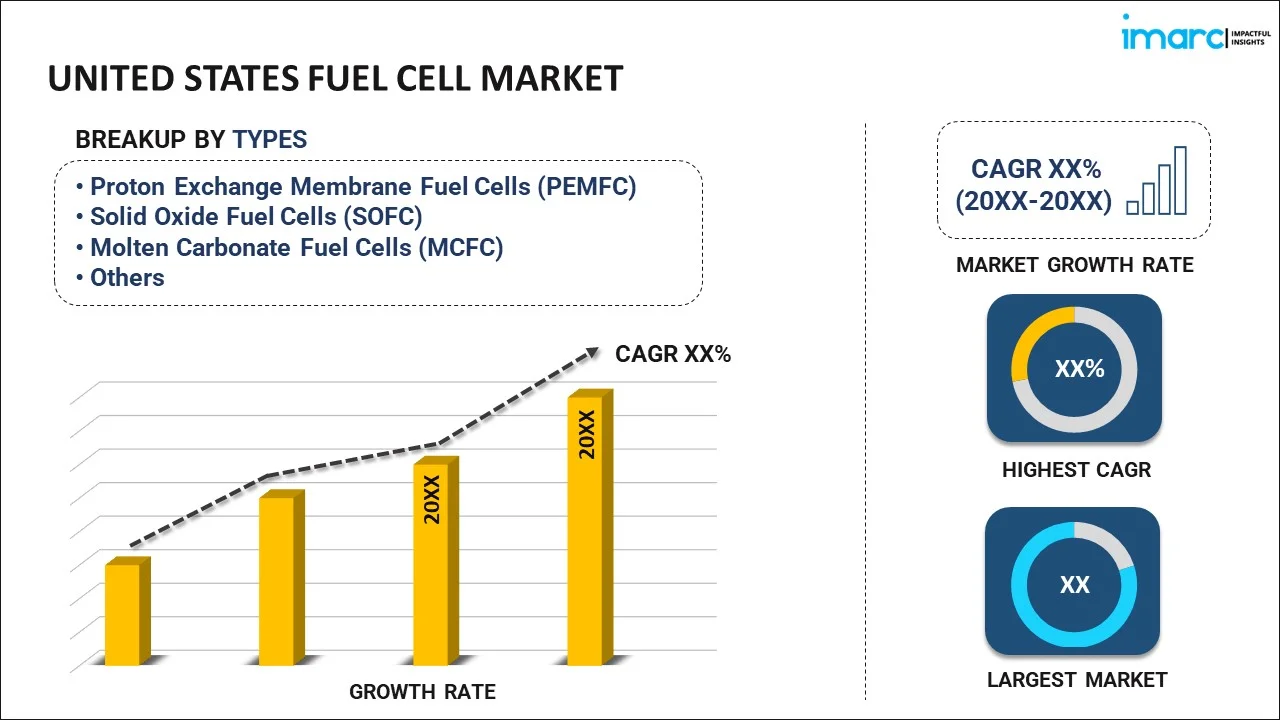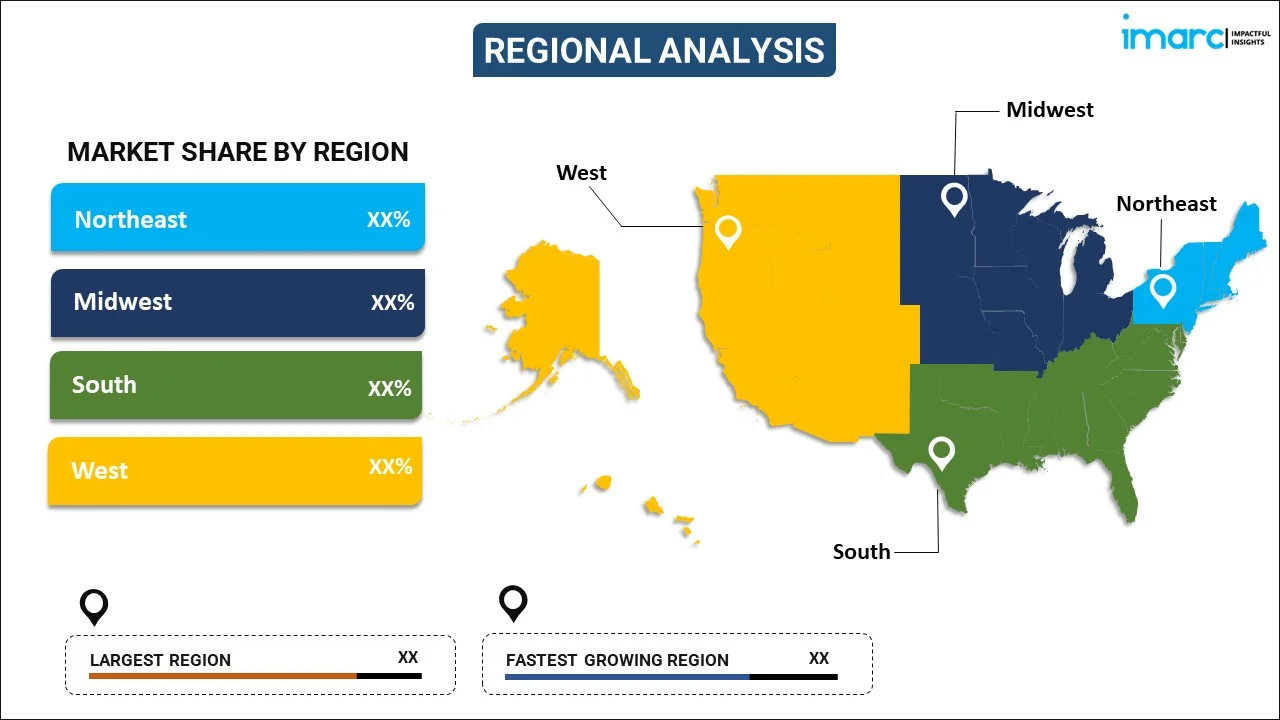
United States Fuel Cell Market Report by Type (Proton Exchange Membrane Fuel Cells (PEMFC), Solid Oxide Fuel Cells (SOFC), Molten Carbonate Fuel Cells (MCFC), Direct Methanol Fuel Cells (DMFC), Phosphoric Acid Fuel Cells (PAFC), and Others), Application (Stationary, Transportation, Portable), and Region 2024-2032
Market Overview:
The United States fuel cell market size is projected to exhibit a growth rate (CAGR) of 19.62% during 2024-2032. The increasing focus on reducing carbon emissions, the sudden shift towards sustainability, rapid technological advancements in fuel cell design and materials, and the integration of fuel cells with renewable energy sources represent some of the key factors driving the market.
|
Report Attribute
|
Key Statistics
|
|---|---|
|
Base Year
|
2023 |
|
Forecast Years
|
2024-2032 |
|
Historical Years
|
2018-2023
|
| Market Growth Rate (2024-2032) | 19.62% |
A fuel cell refers to a device that generates electricity through a chemical reaction involving hydrogen and oxygen, without combustion. It is available in several types, including polymer electrolyte membrane (PEM), solid oxide, alkaline, molten carbonate, and phosphoric acid fuel cells, each differing in materials used and operational temperature. Fuel cells are manufactured using catalysts, electrolytes, and various metals for structural components. They find applications in a wide range of sectors, including transportation, stationary power generation, portable power, space missions, submarines, forklifts, telecommunications, residential power, emergency services, and hydrogen refueling stations. Fuel cells offer high efficiency, reliability, scalability, low emissions, quiet operation, minimal maintenance, rapid refueling, long lifespan, flexibility, and reduced dependency on fossil fuels. Moreover, they are lauded for their environmental friendliness, operational cost savings, energy security, space efficiency, versatility, adaptability, and contribution to a sustainable energy future.
United States Fuel Cell Market Trends:
The increasing focus on reducing carbon emissions and promoting clean energy solutions is one of the major factors boosting the market growth. Along with this, the growing adoption of fuel cells, due to their high efficiency and low to zero emission profiles, is favoring the market growth. Moreover, the implementation of government incentives and regulations encouraging the adoption of clean technologies is creating a positive outlook for the market growth. Besides this, the development of hydrogen refueling stations and the improvement in hydrogen production methods, including green hydrogen production using renewable energy, are contributing to the market growth. Apart from this, rapid technological advancements in fuel cell design and materials, leading to improved efficiency, durability, and cost-effectiveness, are positively impacting the market growth. In line with this, the integration of fuel cells with renewable energy sources like solar and wind power for energy storage and backup power solutions is expanding the market growth. Furthermore, the widespread adoption of fuel cell electric vehicles (FCEVs), driven by environmental regulations and consumer awareness, is providing an impetus to the market growth. Apart from this, the rising utilization of fuel cells for distributed power generation, backup power, and as a part of microgrids is acting as a growth-inducing factor. Along with this, the growing need for reliable, uninterrupted power supply in critical infrastructure, data centers, healthcare facilities, and residential applications is boosting the market growth. Moreover, the integration of fuel cells with other emerging technologies, such as artificial intelligence (AI) for optimized operation and maintenance and the use of advanced materials for enhanced performance, are creating remunerative growth opportunities for the market.
United States Fuel Cell Market Segmentation:
IMARC Group provides an analysis of the key trends in each segment of the market, along with forecasts at the country level for 2024-2032. Our report has categorized the market based on type and application.
Type Insights:

- Proton Exchange Membrane Fuel Cells (PEMFC)
- Solid Oxide Fuel Cells (SOFC)
- Molten Carbonate Fuel Cells (MCFC)
- Direct Methanol Fuel Cells (DMFC)
- Phosphoric Acid Fuel Cells (PAFC)
- Others
The report has provided a detailed breakup and analysis of the market based on the type. This includes proton exchange membrane fuel cells (PEMFC), solid oxide fuel cells (SOFC), molten carbonate fuel cells (MCFC), direct methanol fuel cells (DMFC), phosphoric acid fuel cells (PAFC), and others.
Application Insights:
- Stationary
- Transportation
- Portable
A detailed breakup and analysis of the market based on the application have also been provided in the report. This includes stationary, transportation, and portable.
Regional Insights:

- Northeast
- Midwest
- South
- West
The report has also provided a comprehensive analysis of all the major regional markets, which include Northeast, Midwest, South, and West.
Competitive Landscape:
The market research report has also provided a comprehensive analysis of the competitive landscape in the market. Competitive analysis such as market structure, key player positioning, top winning strategies, competitive dashboard, and company evaluation quadrant has been covered in the report. Also, detailed profiles of all major companies have been provided.
United States Fuel Cell Market Report Coverage:
| Report Features | Details |
|---|---|
| Base Year of the Analysis | 2023 |
| Historical Period | 2018-2023 |
| Forecast Period | 2024-2032 |
| Units | US$ Million |
| Scope of the Report | Exploration of Historical Trends and Market Outlook, Industry Catalysts and Challenges, Segment-Wise Historical and Future Market Assessment:
|
| Types Covered | Proton Exchange Membrane Fuel Cells (PEMFC), Solid Oxide Fuel Cells (SOFC), Molten Carbonate Fuel Cells (MCFC), Direct Methanol Fuel Cells (DMFC), Phosphoric Acid Fuel Cells (PAFC), Others |
| Applications Covered | Stationary, Transportation, Portable |
| Regions Covered | Northeast, Midwest, South, West |
| Customization Scope | 10% Free Customization |
| Report Price and Purchase Option | Single User License: US$ 3699 Five User License: US$ 4699 Corporate License: US$ 5699 |
| Post-Sale Analyst Support | 10-12 Weeks |
| Delivery Format | PDF and Excel through Email (We can also provide the editable version of the report in PPT/Word format on special request) |
Key Questions Answered in This Report:
- How has the United States fuel cell market performed so far and how will it perform in the coming years?
- What has been the impact of COVID-19 on the United States fuel cell market?
- What is the breakup of the United States fuel cell market on the basis of type?
- What is the breakup of the United States fuel cell market on the basis of application?
- What are the various stages in the value chain of the United States fuel cell market?
- What are the key driving factors and challenges in the United States fuel cell?
- What is the structure of the United States fuel cell market and who are the key players?
- What is the degree of competition in the United States fuel cell market?
Key Benefits for Stakeholders:
- IMARC’s industry report offers a comprehensive quantitative analysis of various market segments, historical and current market trends, market forecasts, and dynamics of the United States fuel cell market from 2018-2032.
- The research report provides the latest information on the market drivers, challenges, and opportunities in the United States fuel cell market.
- Porter's five forces analysis assist stakeholders in assessing the impact of new entrants, competitive rivalry, supplier power, buyer power, and the threat of substitution. It helps stakeholders to analyze the level of competition within the United States fuel cell industry and its attractiveness.
- Competitive landscape allows stakeholders to understand their competitive environment and provides an insight into the current positions of key players in the market.
Need more help?
- Speak to our experienced analysts for insights on the current market scenarios.
- Include additional segments and countries to customize the report as per your requirement.
- Gain an unparalleled competitive advantage in your domain by understanding how to utilize the report and positively impacting your operations and revenue.
- For further assistance, please connect with our analysts.
 Inquire Before Buying
Inquire Before Buying
 Speak to an Analyst
Speak to an Analyst
 Request Brochure
Request Brochure
 Request Customization
Request Customization




.webp)




.webp)












